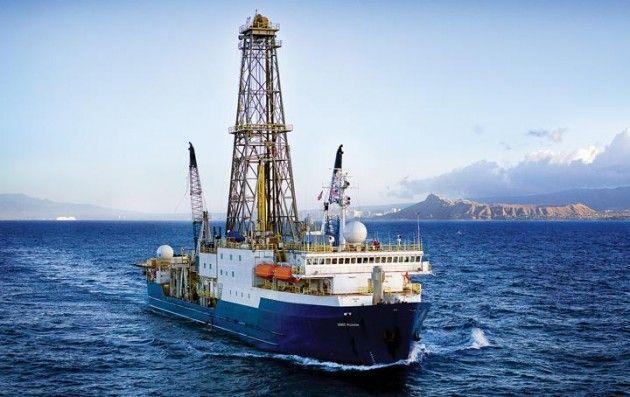From the balmy waters near Hawaii to the frigid seas around Antarctica, researchers with the Integrated Ocean Drilling Program have sailed to the ends of the Earth with a mission to collect samples of rock and sediment from beneath the ocean floor. These samples, or cores, are then delivered to one of three repositories in the world.
“The Integrated Ocean Drilling Program is the largest international earth science program that exists, and it makes A&M exceedingly visible in many different ways,” said Adam Klaus, associate research scientist for the Integrated Ocean Drilling Program.
A&M’s core repository, the only one in the Western Hemisphere, houses more than 100,000 meters of subsurface cores – enough sediment to reach from College Station to Conroe, Texas. Some of the sediments in these cores have been locked beneath the sea floor for millions of years – a regular wealth of information in the right hands.
“This program is designed to document Earth’s history,” Klaus said. “We have 20 to 30 scientists on every expedition who take the cores and start characterizing them to see what secrets they unveil about the Earth, such as climate change or tectonic [behavior]. The scientists then spend the next few years working and then publish their results after that.”
The international marine research program involves more than 20 countries. One team of international scientists, led by Texas A&M’s Heath Mills, recently published its findings about bacterial life deep within sediment cores taken 63 miles southeast of the Kii Peninsula of Japan in the Pacific Ocean.
Bacterial life forms have been observed in sediment cores in previous studies, but the general consensus was that the bacteria were inactive, dormant or dead due to extreme temperatures many meters beneath the sea floor and the limited availability of food for the bacteria.
Mills, lead author of the paper, and his colleagues are suggesting that not only are these bacterial populations alive and active, but they have been for millions of years.
“What we’re looking at is how these single-celled bacteria interact with the environment, and we do that in two ways,” said Mills, an assistant oceanography professor at A&M. “We look at how the bacteria change the environment. We also look at how the environment selects for the different bacterial populations.”
Past studies have identified cells in sediments through DNA analysis, but these methods made it impossible for scientists to determine whether the cells were active. Using an innovative technique that looks at the bacteria’s RNA, Mills and other scientists can now identify which cells are active. So far, Mills has found active cells in cores collected in the Gulf of Mexico, the Great Barrier Reef and the coast of Japan.
A staggering one- to two-thirds of the Earth’s biomass – mass of biological life forms – is thought to exist beneath the seafloor. If even a small percentage of these cells are active, there could be large consequences for the seafloor’s chemistry, geology and physical properties, which in turn affect the oceans, Mills said.
“Current estimates are that the entire ocean volume is filtered through the subsurface every 100,000 to 200,000 years,” Mills said. “If the oceans are going through [the subsurface], that means that the microbial life that’s within it is acting on it, changing the ocean’s chemistry and the effect of the oceans on the planet and everything with it.”
Acknowledging that these bacteria are alive and active is not enough, Mills said. The next step is to determine whether different types of bacteria exist at varying locations on Earth.
One scientist handling this feat is a former graduate student of Mills, Brandi Reese, who is now a post-doctoral research assistant at the University of Southern California.
“My goal is to determine how related or unrelated the deep subsurface locations are to one another,” Reese said. “I will use these sites and the ones I am working on now to create a bio-geographical map of the distributions of microbial communities.”
Undergraduate students are also involved in Mills’ research. Junior biology major Laura Zinke said she enjoys the unique approach of RNA analysis.
“One of the cool things about this lab is that it links the geochemistry with the biology, which gives a more complete picture of what’s actually going on,” Zinke said. “That’s actually the reason that I got interested in this lab.”
Another of undergraduate researcher who helped identify active bacteria in the Great Barrier Reef, senior bioenvironmental sciences major Cruz St.Peter, will graduate this spring with hopes of joining the Integrated Ocean Drilling Program team.
“The biology aspect of subsea floor life, that there are actually things living down there and things that are active down below the seafloor, is really cool to me,” St. Peter said. “Heath knows a lot and I’ve learned so much from him, and I really feel privileged to have been involved in his research.”
Twenty years ago scientists didn’t know that life could exist beneath the seafloor, let alone be alive and active as well, Mills said.
“We’ve now set the bar a little higher,” Mills said.
Beneath the ocean floor
April 17, 2012
Donate to The Battalion
Your donation will support the student journalists of Texas A&M University - College Station. Your contribution will allow us to purchase equipment and cover our annual website hosting costs.




















